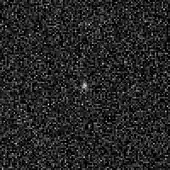Leda (moon)
Leda /ˈliːdə/, also known as Jupiter XIII, is a prograde irregular satellite of Jupiter. It was discovered by Charles T. Kowal at the Mount Palomar Observatory on September 14, 1974, after three nights' worth of photographic plates had been taken (September 11 through 13; Leda appears on all of them).[1][9] It was named after Leda, who was raped[10] by Zeus, the Greek equivalent of Jupiter (who came to her in the form of a swan). Kowal suggested the name and the IAU endorsed it in 1975.[11]
.jpg.webp) Discovery image of Leda taken by the Palomar Observatory in 1974 | |
| Discovery [1] | |
|---|---|
| Discovered by | Charles T. Kowal |
| Discovery site | Palomar Observatory |
| Discovery date | 11 September 1974 |
| Designations | |
Designation | Jupiter XIII |
| Pronunciation | /ˈliːdə/[2] |
Named after | Λήδα Lēdā |
| Adjectives | Ledian /ˈliːdiən/,[3] Ledean /ˈliːdiən/[4] or /liːˈdiːən/[5] |
| Orbital characteristics [6] | |
| Epoch 16 February 2017 (JD 2457800.5) | |
| Observation arc | 42.60 yr (15,561 days) |
| 0.0746988 AU (11,174,780 km) | |
| Eccentricity | 0.1628287 |
| +241.33 d | |
| 201.37181° | |
| 1° 29m 30.204s / day | |
| Inclination | 28.41392° (to ecliptic) |
| 194.94309° | |
| 311.19223° | |
| Satellite of | Jupiter |
| Group | Himalia group |
| Physical characteristics | |
Mean diameter | 21.5±1.7 km[7] |
| Albedo | 0.034±0.006[7] |
| 20.2[8] | |
| 12.7[6] | |
Leda belongs to the Himalia group, five moons orbiting between 11 and 13 Gm from Jupiter at an inclination of about 27.5°.[12] The orbital elements given here are as of January 2000, but they are continuously changing due to solar and planetary perturbations.

See also
References
- Kowal, C. T.; Aksnes, K.; Marsden, B. G.; Roemer, E. (1974). "Thirteenth satellite of Jupiter". Astronomical Journal. 80: 460–464. Bibcode:1975AJ.....80..460K. doi:10.1086/111766.
- "Leda". Lexico UK Dictionary. Oxford University Press.
- Ken Monteith (2007) Yeats and theosophy, p. 10
- Wit Pietrzak (2011) Myth, Language and Tradition: A Study of Yeats, Stevens, and Eliot in the Context of Heidegger's Search for Being, p. 70–72
- R.W. Chapman (1939) Adjectives from Proper Names, p. 55
- "M.P.C. 104797" (PDF). Minor Planet Circular. Minor Planet Center. 10 May 2018.
- Grav, T.; Bauer, J. M.; Mainzer, A. K.; Masiero, J. R.; Nugent, C. R.; Cutri, R. M.; et al. (August 2015). "NEOWISE: Observations of the Irregular Satellites of Jupiter and Saturn" (PDF). The Astrophysical Journal. 809 (1): 9. Bibcode:2015ApJ...809....3G. doi:10.1088/0004-637X/809/1/3. S2CID 5834661. 3.
- Sheppard, Scott. "Scott S. Sheppard - Jupiter Moons". Department of Terrestrial Magnetism. Carnegie Institution for Science. Retrieved 26 November 2020.
- Brian G. Marsden (20 September 1974). "IAUC 2702: Probable New Satellite of Jupiter". International Astronomical Union.
- Leda and the Swan
- Marsden, Brian G. (7 October 1975). "Satellites of Jupiter". International Astronomical Union.
- Jacobson, R. A. (2000). "The orbits of outer Jovian satellites" (PDF). Astronomical Journal. 120 (5): 2679–2686. Bibcode:2000AJ....120.2679J. doi:10.1086/316817.